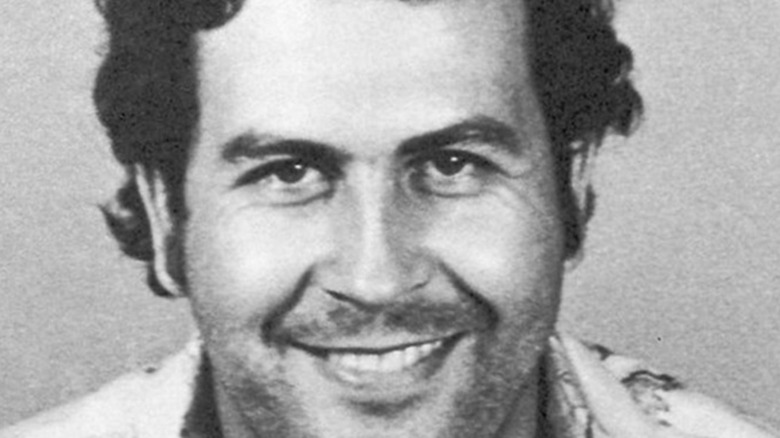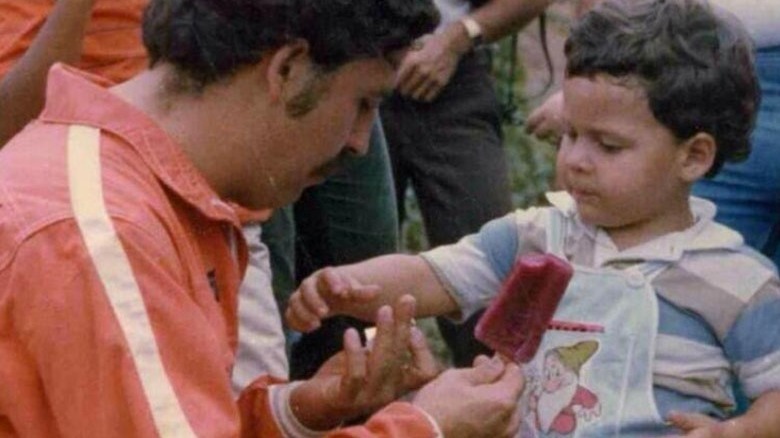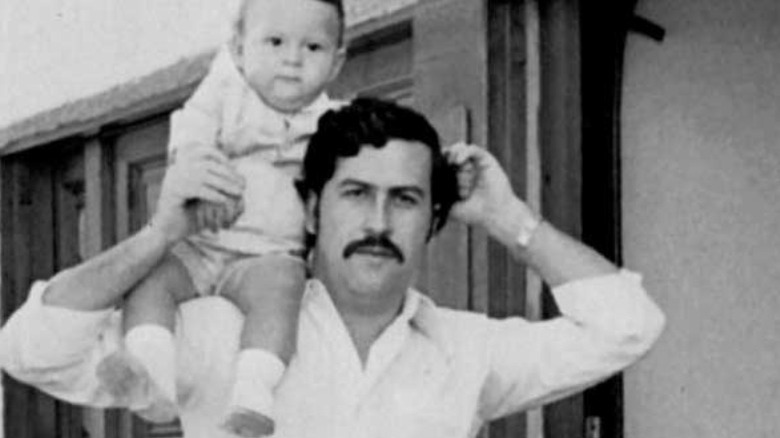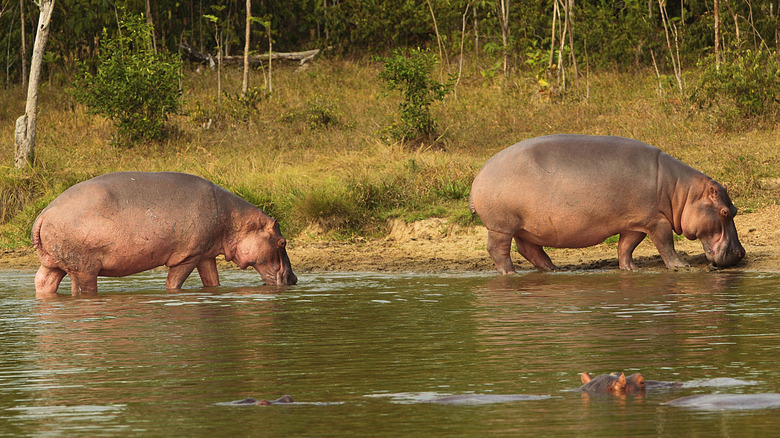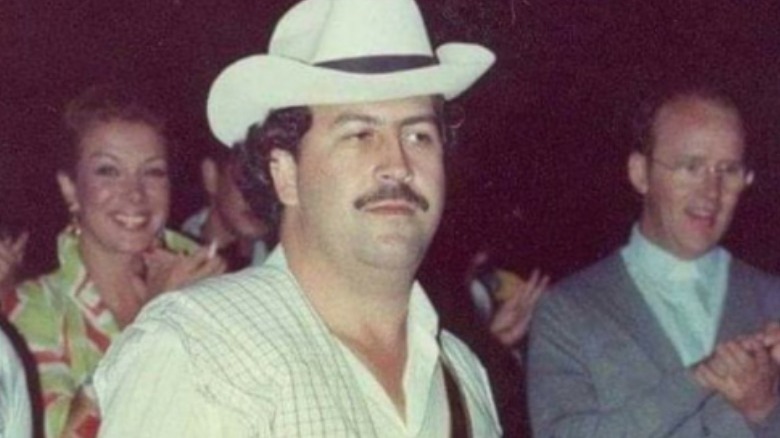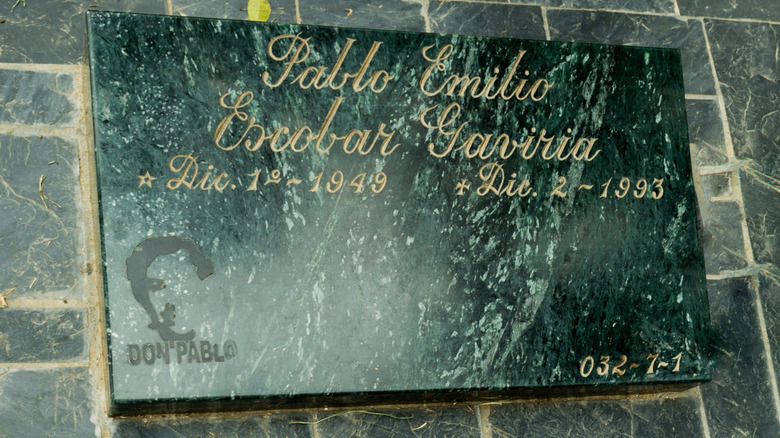The Untold Truth Of Pablo Escobar
Pablo Escobar was one of the world's richest men and most notorious criminals.
Born in Colombia in 1949, Escobar first turned to crime in his teenage years. According to Britannica, he reportedly began by creating fake diplomas and report cards as well as stealing cars, stereo equipment, and tombstones in order to make a profit. Escobar was first arrested in 1974, in his mid-20s, for stealing a car.
Before long, Escobar had branched out into drug smuggling and gotten to work building an empire of illegality. His work as the leader of the Medellín drug cartel would ultimately make him a multibillion-dollar fortune and lead to the 1993 shootout that resulted in his death at the age of 44.
Despite the government trails and investigations, endless media coverage, and Hollywood biopics, there is a lot that remains uncertain about Escobar. He's a figure of much debate among government officials, rival gang members, and fellow Colombians alike. Here are a few ways in which he has split opinion, raised eyebrows and questions, and ultimately left a lingering impact on the public.
Pablo Escobar was deemed the 'Robin Hood' of Colombia
Part of the reason why Pablo Escobar is a subject of such fascination is his contradictions. According to NBC News, a 1983 article in the Spanish news magazine Semana deemed Escobar the "Robin Hood" of Medellín, Colombia. Escobar regularly criticized his local area's police brutality issues, and famously referred to his 1991 surrender as "a sacrifice for peace." With this kind of messaging, he positioned himself as a people's hero, and the government and its institutions as the real enemy.
A 2018 New Yorker article highlighted the fact that Escobar was beloved in Medellín and seen as a hometown hero. The "charismatic" and ambitious drug lord posed for photos and signed autographs as any celebrity would. His brother, Roberto, spoke to The New Yorker about why Pablo impacted so many Colombians. "It's because Pablo helped the poorest people of this country," he said. When asked "if his brother was a good man," Roberto said, "To me he was."
Billions of Pablo Escobar's dollars were burned, eaten by rats, or otherwise destroyed
Pablo Escobar was once considered "the seventh-richest person on the planet," per BBC. It could also be said that the notorious criminal had so much money he didn't know what to do with it — literally. In September 2020, BBC reported that Escobar's nephew, Nicolás Escobar, discovered a plastic bag containing $18 million stashed inside the wall of his apartment in Medellín, which previously belonged to his uncle. A lot of the cash was "decayed and no longer usable." "The smell [inside] was astonishing," Nicolás told the BBC. "A smell 100 times worse than something that had died." Escobar reportedly hid several million-dollar stashes across his properties, and Nicolás told the news outlet it was not the first time he'd found one of them.
Escobar was reckless with his money, and not just when it came to spending it. According to Britannica, the drug trafficker allegedly once set $2 million aflame to keep his daughter warm while they were on the run from the law around 1992. The billionaire reportedly wrote off $2.1 billion each year because it had been "eaten by rats," "destroyed by the elements," or "simply lost."
Pablo Escobar is partially responsible for South America's hippopotamus population
One of the major lasting impacts of Pablo Escobar's life's work is South America's "cocaine hippo" problem. According to the BBC, while the rise of the "cocaine hippos" began after Escobar's death, the ground-zero of the phenomenon was the drug lord's private zoo at his luxury estate known as Hacienda Napoles.
After authorities seized the estate in 1993, they sent many of Escobar's animals to nearby zoos, but the hippopotamuses remained. "It was logistically difficult to move them around, so the authorities just left them there, probably thinking the animals would die," Nataly Castelblanco, a Colombian biologist, told the BBC.
Instead, the species multiplied and became the largest herd outside their native Africa, resulting in an environmental threat. South America proved to be fertile ground for hippos to reproduce because they do not run into the droughts or predators that threaten their survival in Africa. "It is obvious that we feel sorry for these animals, but as scientists we need to be honest," Castelblanco told the BBC. "Hippos are an invasive species in Colombia and if we do not kill a part of their population now, the situation could be out of control in just 10 or 20 years."
Pablo Escobar built his own luxury prison
Although Pablo Escobar spent years on the run from the law, he famously surrendered in 1991. But one of the world's richest and most powerful men was not prepared to rough it in any old prison. Instead, he had his own luxury prison built, complete with views overlooking Medellín and his own business associates in charge, per the New York Post. He named the so-called prison "La Catedral."
In Steve Murphy and Javier F. Peña's 2019 book "Manhunters: How We Took Down Pablo Escobar," Peña described La Catedral as "surprisingly neat" and "a country club filled with luxury items, such as state-of-the-art televisions, refrigerators and stereo equipment" (via the New York Post). Peña also described the suites throughout the compound as "beautifully appointed, with planters, hanging baskets, and luxurious upholstery and drapes."
"Escobar had a thing about clean and well-proportioned bathrooms, and each time we raided a safe house that Escobar used, we always found a curiously sparkling bathroom with brand-new fixtures," Peña continued.
Escobar reportedly kept his office stocked with self-published, leather-bound books — some of which were full of cartoons that lampooned the United States, and others which focused on "how to take care of homing pigeons," since the birds were used to deliver messages between cartel members. He also kept files that included copies of his own wanted posters and, as Peña recalled, "threatening notes from his enemies" (via the New York Post).
There has been some debate around the details of Pablo Escobar's death
Pablo Escobar was shot and killed on December 2, 1993. According to Business Insider, Escobar was running across a rooftop in Medellín from members of the military and the Colombian police when he was shot down. Upon Escobar's death, the United States government published a photo of his body splayed across the roof, covered in blood, and surrounded by smiling, gun-toting police officers and military members.
But there has been some dispute about the exact details of Escobar's death. Members of Escobar's own family, gang members, and even intelligence documents have brought into question whether it was actually the troops in the photo that killed Escobar. Official reports state that it was the Search Bloc, a specialized police unit tasked with focusing on the cartel, that killed Escobar.
At the time, it was reported that Escobar had been shooting back with his own weapon, which has made way for some speculation that he may have shot and killed himself during the shootout.
Another account from Diego Fernando Murillo, aka "Don Berna" — a member of the Los Pepes group, which was made up of Escobar's rivals — suggests that Los Pepes attended the raid alongside the Search Bloc that day, and that it was Berna's own brother who fired the lethal shot, per Insight Crime.
In any case, one thing is for sure: The late drug cartel leader Pablo Escobar remains a notorious mystery to many.
